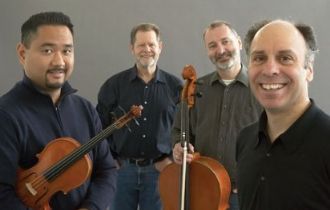|
Symphony
YOUTHFUL VIRTUOSITY ON DISPLAY AT USO'S MAY CONCERTS
by Peter Lert
Saturday, May 17, 2025
Symphony
MYSTICAL PLANETS AND LIVELY GERSHWIN ORTIZ AT FINAL SRS CONCERT
by Peter Lert
Sunday, May 4, 2025
Symphony
VSO'S CONCERT MUSIC OF TIME, MUSIC OF PLACE
by Peter Lert
Sunday, April 27, 2025
Choral and Vocal
VOCAL ELEGANCE AND FIRE AT THE 222'S RECITAL APRIL 26
by Pamela Hicks Gailey
Saturday, April 26, 2025
CANTIAMO SONOMA SINGS AN INSPIRED GOOD FRIDAY MOZART REQUIEM CONCERT
by Pamela Hicks Gailey
Friday, April 18, 2025
DRAMATIC SHOSTAKOVICH SYMPHONY CLOSES PHILHARMONIC'S 25TH SEASON
by Terry McNeill
Sunday, April 13, 2025
LARGE COLLEGE OF MARIN AUDIENCE GREETS STOPHER ARTISTRY
by Terry McNeill
Saturday, April 5, 2025
Chamber
FRISSON DELIVERS SHIVERS OF DELIGHT
by Abby Wasserman
Sunday, March 30, 2025
OLD AND MOSTLY NEW IN SRS MARCH CONCERT IN WEILL
by Peter Lert
Saturday, March 22, 2025
Symphony
TWO FORMIDABLE SYMPHONIES AND PURPLE MOUNTAINS AT SRS CONCERT
by Peter Lert
Sunday, February 23, 2025
|
 |
 Alexander String Quartet |
THE ALEXANDER SQ AT LAST PLAYS OAKMONT
by Terry McNeill
Thursday, May 13, 2010
For nearly 25 years the Alexander String Quartet has been the preeminent chamber music group in Northern California, but despite many invitations they have never appeared on the popular Oakmont Concert Series season. Schedule conflicts with the SRJC Chamber Series and the Quartet’s far-flung travel commitments were finally overcome May 13 when the esteemed foursome appeared on the Berger Auditorium stage before 225 chamber music aficionados.
In a concert dedicated to the memory of Lore Kahane, a beloved Oakmont resident who died May 11, the Alexander was joined by Marin pianist June Choi Oh in a program that was both novel and routine. Mozart’s early Quartet in F major, K. 168, began the festivities, a four-movement work the congenial Alexander can play in their sleep. The opening Allegro was a model of suave interplay, the bucolic themes deftly passing between instruments. In the following Andante the mood became somber, but never plodding, with Sandy Wilson’s cello lines highlighting a threnody during long stretches of pianissimo. A quick Viennese dance characterized the Menuetto with bursts of color from first violin Zakarias Grafilo, and a quick fugue, light in texture, finished the work. The unison strings were perfectly together, the sound not large but carrying well and dying out to a whisper.
Perhaps the most popular piano quintet, Schumann’s work in E-Flat Major, Op. 44, closed the first half in fine style. The big second theme of the opening Allegro Brillante came richly in a duet from violist Paul Yarbrough and Mr. Wilson, though in this Schumann work from 1843 the strings often double the piano part or fill in with isolated phrases. Ms. Oh is a fluent pianist without being a very demanding collaborator, and the many repeats of the theme become almost tiresome. But it is a heavenly theme, constantly embellished in the cello part. In the march-like second movement there was an elegant “question and answer” motif incorporating different rhythms that was effectively played, albeit with a raspy tone from Mr. Yarbrough. Often the pizzicato sections reflected music on “tiptoe” but with consummate delicacy. The Scherzo was played with controlled recklessness and drew some audience applause at the powerful ending, just one movement short of completion. That finale, Allegro man non troppo, found the viola sound back in the mix and just the proper amount of majesty in the country dance section leading to the coda. It was a high-level performance in every way but lacking for me the final bit of energy and abandon. A polished Schumann but slightly underplayed.
Elgar’s three-movement A Minor Quintet, Op. 84, closed the afternoon and proved to be a tough work to get one’s arms around. It’s richly inventive and develops mostly in an inexorable Brahmsian way, with orchestral power in the opening Moderato–Allegro. It’s a work that on the whole contains many segments, with some commonality in the serene sections of the Moderato and the fetching Adagio. The Alexander drove the long first movement urgently, at times covering the piano part and making the most of unison sections and at the end a drawn out and tranquil diminuendo.
Rich romanticism pervaded the second movement, which the Quintet seemed to perceive as an homage (to British WW I dead? to the demise of the Edwardian era?). Their playing over many convoluted but deceptive cadences was captivating, the final release a wistful cessation of sound. Violinist Frederick Lifsitz's subtle discovery of inner voices in the movement was telling. The finale began with what sounded like a quote from the Moderato and moved into nervous animation and prismatic modulations. Ms. Oh’s fast running right-hand figures and sweeping arpeggios added sonic sparkle and the choral-like section was played by the entire group with careful control of the complex rhythms.
On balance, the Elgar was for me the afternoon’s most effective work, but in an odd way, as few could leave the hall humming tunes as with the Schumann Quintet. I suspect the Alexander and Ms. Oh lavished rehearsal time on this lush but intricate work, to a felicitous end.
|

